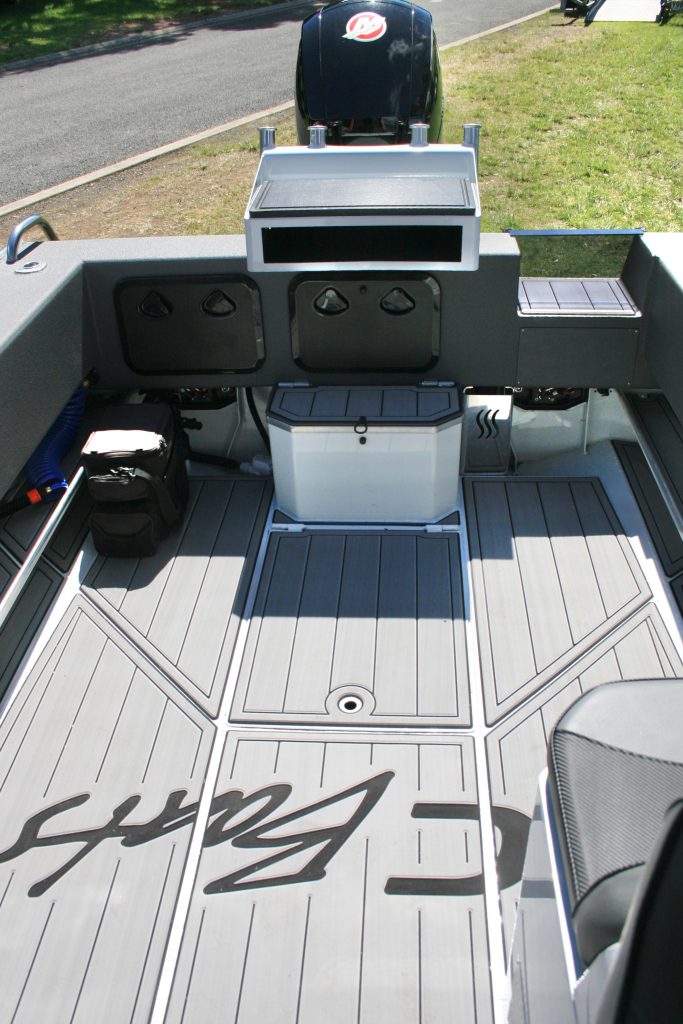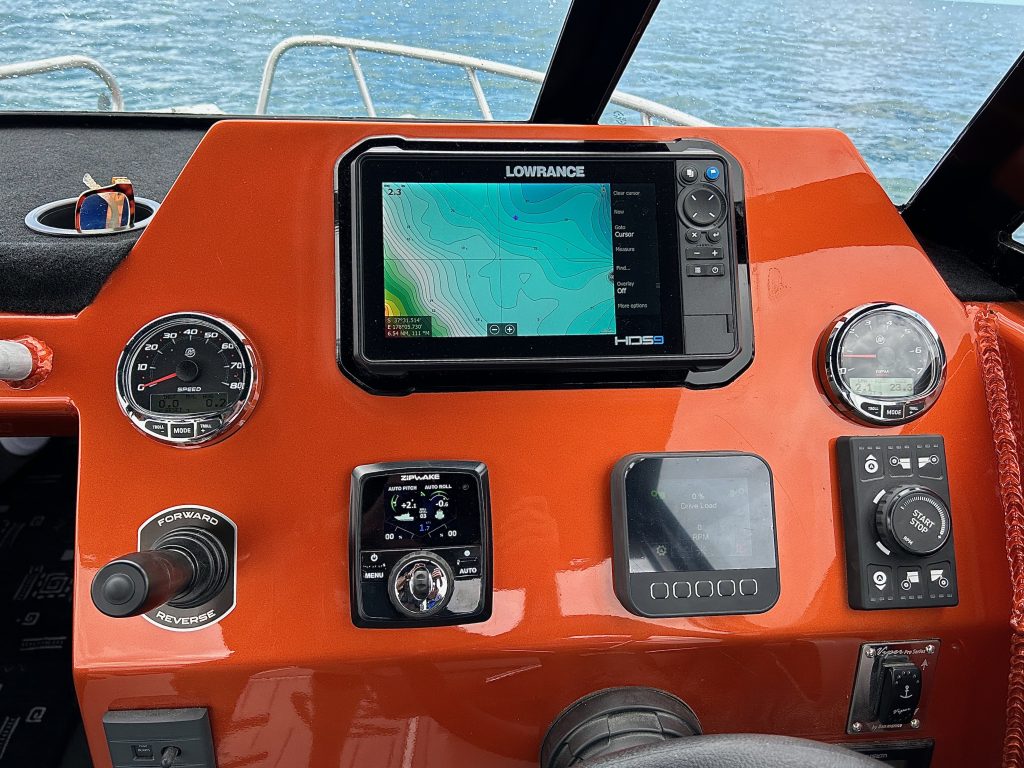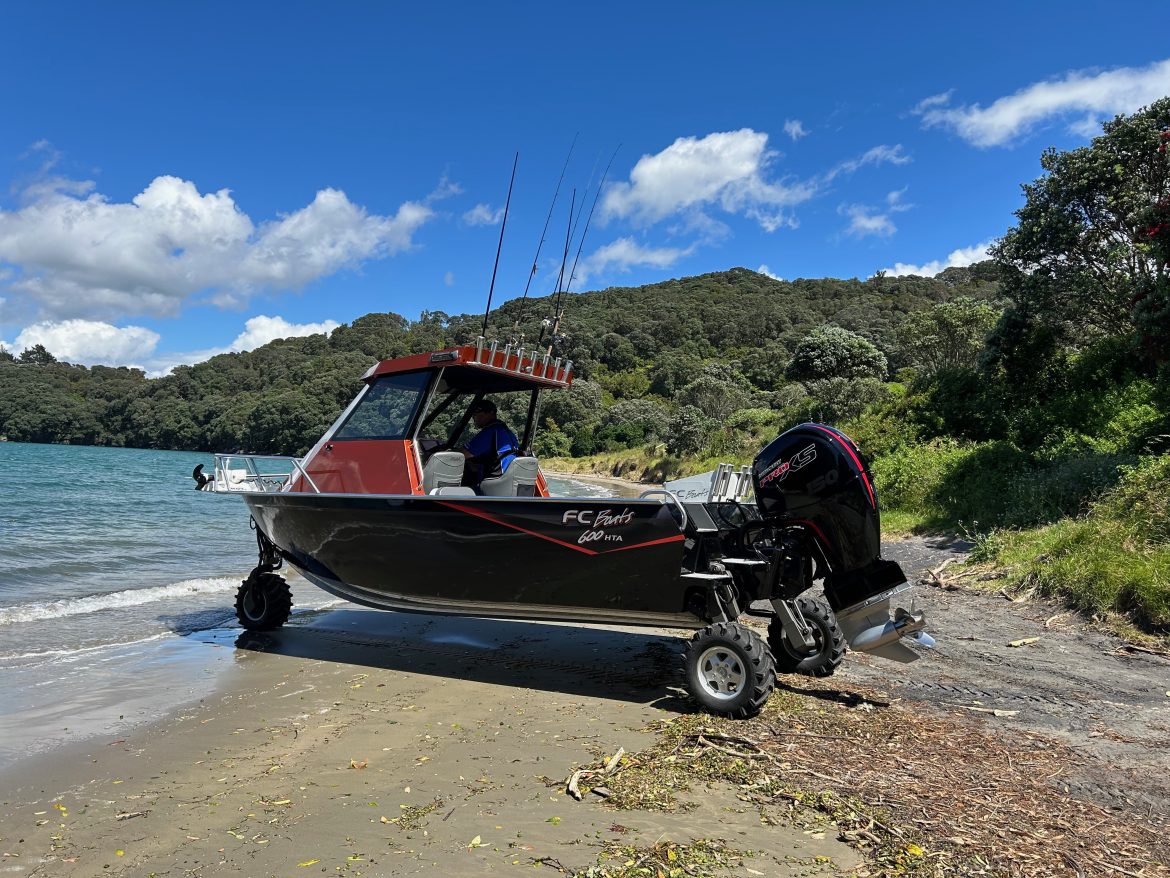While imminently practical, amphibious trailer boats are not generally renowned for their performance. That certainly doesn’t apply to the new FC 600HTA
Amphibious boats require a lot of extra stuff. There’s that second engine (required to raise and lower those front and back wheels and power them along the road, ramp or beach). There are the wheels themselves and then there is all the additional engineering. And none of it is light. So, when Ross Christensen and his team at FC Boats started fielding inquiries for amphibious versions of their popular 560 and 600 models, they had a problem. Although there was clearly a market for these smaller amphibious models, the Anura amphibious package they had been successfully installing in their FC 700s weighed in at a substantial 500kgs. And while the 7-metre hardtop was large enough to cope with that extra half a tonne, the significantly smaller 600s and 560s weren’t. FC Boats has built its not inconsiderable reputation on creating boats specifically for those who go fishing and diving.
They are renowned for their practicality, their load carrying and their performance and there was no way Ross was going to risk sacrificing any of that simply to add another model or two to his line-up. Yet, as a vastly experienced retailer, he hated the idea of not being able to satisfy his customers’ demands. He was therefore greatly relieved when the team at Anura informed him that they had managed to create a new, substantially lighter amphibious package. Named the S15, it weighed in at just 300kgs, a little more than half that of the original package. Suddenly, amphibious 560s and 600s seemed possible, although there was still work to do. “We did a lot of weight testing and, as a result, made some slight modifications to our hull design,” he says. “These have allowed us to create a really well-balanced vessel that performs really well and doesn’t require huge horsepower to drive it.”

We encounter the new FC 600HTA in the Anzac Bay reserve at Waihi Beach, at the northern end of the Bay of Plenty. It makes an attractive sight, its striking orange superstructure on a black hull immediately drawing interest as Ross lowers the vessel’s wheels and drives it off its transport trailer. Sitting on board, under the shade of the flowering pohutukawa, it is hard not to be impressed by how little impact the installation of the Anura package has had on the interior layout. The main body of cockpit, from the seating under the hardtop to the transom, is almost completely clear with no awkward engine boxes or other protuberances to get in the way of the serious business of fishing and/or kitting up for a dive. The side decks are wonderfully wide and a joy to sit on, meaning there has been no need to install any sort of space-hungry transom seats (although one could, if one really wanted to, perch on the top of the centrally positioned live bait tank). These wide gunwales are also home to much of the 600 HTA’s substantial flotation.
All the hydraulics and other engineering for the rear wheels has been hidden under the transom. Although it is pretty easy to access should one need to, it doesn’t impinge in the cockpit, either visually or by taking up valuable space. Indeed, all one sees when looking aft is the FC Boats baitboard. Painted white, this aluminium unit comes complete with a handy open locker under, a black hard nylon board with for’ard and side slits draining into an aft channel and then overboard and four polished aluminium rod holders. There is a total of 18 of these on board: these four, three in each of the side decks and 8 in the rocket launcher. Other helpful cockpit features are the Seadek floor panels throughout, the underfloor locker (designed to hold two dive bottles), the side shelf lockers (one per side), the Jabsco wash down hose and the wee Perspex slide providing protection above the step through to the platform. The FC 600HTA’s fuel filter, electric connections and lithium hybrid start/house battery are also safely housed in a pair of lockers set high in the transom.

COMPACT PACKAGE
The heart of the Anura amphibious package (the 25hp Honda IGX800 EFI petrol engine, the hydraulic reservoir and pump system) is encased in a lightweight metal box under the passenger seat, in the space where the king/queen seat module would normally be. This compact arrangement means the only area “lost” is the rear facing seat and the stowage space underneath, a ridiculously small price to pay for the additional convenience it provides. The hardtop and cabin areas are all attractively finished with black Frontrunner fabric, there are side lockers for both the skipper and crew for things such as sunglasses, phones, keys and the like and there is a sturdy polished aluminium hand rail above the cabin entrance and footrests on both sides. The wraparound windscreen consists of panels that are all straight (as opposed to curved) to make them easier to replace should there be an accident. Although none of these open (and there is no opening sunroof ) ventilation, even on windless days, is less of a problem than one might imagine. This is because the 600 HTA’s cabin hatch is not only of a substantial size, it has also been positioned near vertically, ensuring great air flow on even the calmest days. The cabin itself is more of a stowage area than a resting place although the bunks are long enough for smallish children to lay down should they need to. There is some stowage under the bunks although the 24v AMPS lithium battery for the Minn Kota occupies some of this.

WELL LAID OUT
Considering the amount of “kit” on board, the FC 600HTA’s dash is a surprisingly uncluttered and well laid out affair. Pride of place is taken up with the Lowrance HDS9 MFD. However, although this is FC Boats’ demonstrator, Ross says they are happy to install any brand of MFD the client prefers, as long as it is a touchscreen model and can take the camera feed from over the for’ard wheel. The MFD is flanked by the two Mercury Smart Craft engine gauges (for the Mercury 150hp ProXS outboard) and, under these, the start/stop panel, gauge and toggle control for amphibious package and the Zipwake control. Lower down is the BEP DC switch panel, the GME VHF, the Fusion stereo and the control panel for the Viper drum winch. The Minn Kota is controlled by a separate remote. Ross and his team have also used the redesign process to tweak the 600’s foredeck. They have removed the bow sprit and instead offset both the Minn Kota and Vipercontrolled anchor to ensure the boat’s LOA is below 7m. This, combined with the hardtop being kept as low as possible (yet still easily accommodating those over 6ft) means the 600HTA will fit in a standard garage with a 2.4m high door.

STUNNING PERFORMANCE
Although the weather gods had given us a fairly stiff westerly, they had also given us a pretty fine day and a nice high tide. This meant that Bowentown’s often notorious bar was in a reasonably placid state, ideal for, hopefully, getting some good shots of the 600HTA leaping off the swells. First, however, we had to get from up on the reserve down to the beach ramp, a delightfully simple, nofuss process that perfectly demonstrates the increasing popularity of these amphibious boats. The button to start the secondary engine is simply pushed, the toggle pushed forward and the boat is on way its way down the path, across the sand and into the water. Once afloat, the wheels are raised and we are ready to go. It really couldn’t be much simpler. Once at the bar, Ross puts the 600 HTA through its paces and, as the photos show, this is a pretty impressive performance. Quick to plane and to accelerate up through the range, it easily handles the incoming swell: leaping high off the tops, landing softly on the other side and riding surprisingly high and flat throughout. Racing back down the swells to set up for another run, it is clear there are no “downhill” vices on show either.
This might be a boat with protruding wheels front and rear and an additional 300kgs on board but it sure doesn’t look or perform like it. Photos in the can, we leave the bar and run along the waters off the beach, recording our speed and fuel consumption across the rev ranges. We hit a top speed of 34.9 knots and enjoy cruising speeds of 19.5 knots (at 4000rpm) and 24 knots at 4500rpm. Yet, as impressive as the performance so far as been, it pales when it comes to the 600HTA’s ability to handle tight turns, even at close to full throttle. Obviously thinking it is a high-performance jet boat rather than a rather more staid fisher, it literally turns on a dime, sliding sharply around without any hint of letting go or misbehaving in any way. What’s more, thanks to the Zipwake auto trim tabs, the driver need only concentrate on turning the wheel, stroking the throttle and adjusting the engine trim for the take-offs, the exceptionally tight turns and whether one is heading into or down the swells. There is, despite the brisk westerly, no need at all to worry about the port/starboard trim; unusually for a 6m hardtop, regardless of our direction, we were never running on anything other than an even keel.

CONCLUSION
Ross Christensen founded FC Boats some 12 years ago in the belief that there was an untapped market for simple, uncomplicated fishing boats; boats that didn’t try to be all things to all people but instead offered just the features and the value wanted by Kiwi fishers and divers. Some 1500-odd boats later it is clear that he was right. By his own admission, FC Boats are now sitting in a real sweet spot: still small enough to be able to customise but large enough to be able to afford in-house designers, CAM-CAD operators and engineers and to make changes when they’re required. And that, I think it’s safe to say, is perfected demonstrated by this new FC 600HTA.
SPECIFICATIONS
- Designer FC Boats Hamilton
- LOA 6.959m
- LOH 6.018m
- Beam 2.35m
- Deadrise Variable (17 degrees at transom)
- Displ (Dry) 1500kgs
- Max Speed 34.9
- Construction Aluminium
- Fuel Cap 150L
- Engines Make Mercury 150hp ProXS
- Trim Tabs Zipwake
- Lighting Narva LED
- MFD Lowrance
- Windlass Viper
- Ent System Fusion
- Flooring Seadek
FUEL & PERFORMANCE DATA
RPM | Knots | L/h | L/NM | Range (NM) |
| 1000 | 4 | 3.1 | 0.78 | 170 |
| 1500 | 5.4 | 4.5 | 0.84 | 160 |
| 2000 | 6.5 | 7 | 1.1 | 120 |
| 2500 | 7.4 | 10 | 1.4 | 96 |
| 3000 | 9.4 | 14.3 | 1.6 | 84 |
| 3500 | 13.4 | 19.4 | 1.5 | 90 |
| 4000 | 19.5 | 23.1 | 1.2 | 110 |
| 4500 | 24 | 29.1 | 1.3 | 100 |
| 5000 | 28.1 | 35.6 | 1.3 | 100 |
| 5500 | 30.9 | 45.1 | 1.5 | 90 |
| 6000 | 34.9 | 54 | 1.6 | 84 |
L/NM is calculated to two significant figures and rounded up. Range is calculated to two significant figures and rounded down. To allow for adverse conditions, range is calculated on 90% of the fuel capacity.



